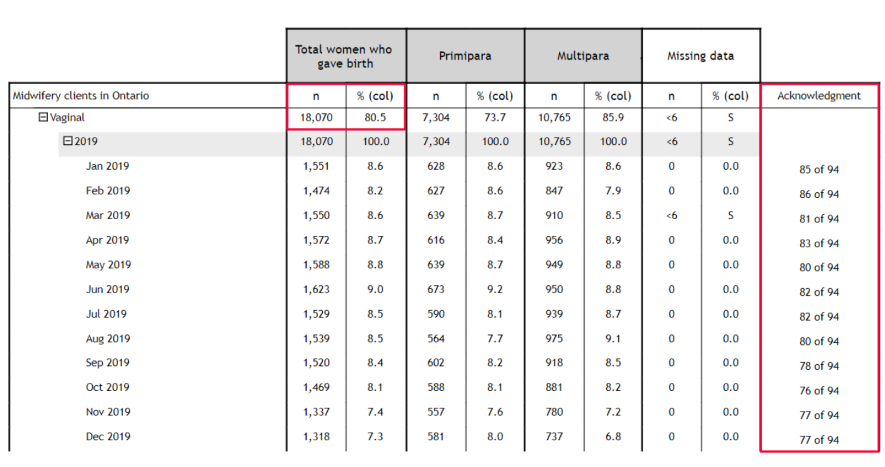Midwifery data matters

January 5, 2021
Imagine you are investigating the rates of vaginal deliveries for midwifery clients in Ontario. As a midwife, you may be interested in comparing your own individual statistics, or your practice group’s statistics, to the midwifery provincial average. Or, you may be preparing a presentation for interprofessional rounds at your hospital, or conducting research aimed at improving birth outcomes. The BORN Information System (BIS) would be an excellent place to begin your data collection.
If you were to run a clinical report (PDF, 877 KB) for the 2019 calendar year, you would find that 80.5% of midwifery clients had a vaginal birth. But did you know that this data only represents the number of vaginal deliveries from 76 out of 94, or just over 80%, of midwifery practice groups (MPGs)? This is because, while all midwives must enter their clinical data into the BIS to bill for care, there is a final step that is required each month before the data set is considered complete: data acknowledgement.
Acknowledgement is an administrative step to verify that all of the data entered into BORN is free of flagged errors and inconsistencies, and that birthing parents are accurately linked to their newborns. When data is acknowledged, this signals to BORN that a practice group or hospital confidently stands behind their data. Only data which is acknowledged is included in the provincial dataset and comparators in clinical reports.
Every month we do not acknowledge our data, we are unable to view thousands of data points that set midwives apart from other health care providers and demonstrate rationale for important practices such as early discharge, delayed cord clamping, skin-to-skin, expectant management and more.
– ‘Remi Ejiwunmi, RM
In our example regarding vaginal birth deliveries, only 76 out of 94 midwifery practice groups acknowledged their data for every month of 2019. This means that 18 practice groups have yet to acknowledge some (or all) of their data for 2019, and therefore their data does not appear on the report. Without knowing how many clients were cared for in each of these practice groups, we cannot accurately determine how much data is missing. As a result, you cannot accurately compare the provincial vaginal birth rate for all midwifery clients to the vaginal birth rate at your practice group, nor can you precisely determine the true provincial average, through this clinical report.

Why Should Your MPG Acknowledge BORN Data?
BORN data acknowledgement matters because midwifery data matters. A lack of consistent data acknowledgement restricts midwives and midwifery stakeholders from making accurate and fulsome comparisons between midwifery outcomes and the outcomes of other health care providers.
“Midwives' unique model of care can be validated by the excellent outcomes that we collect in BORN. Unfortunately, until data is acknowledged in BORN, it's as if it doesn't exist,” laments ‘Remi Ejiwunmi, a registered midwife and active user of BORN data for midwifery research. “Every month we do not acknowledge our data, we are unable to view thousands of data points that set midwives apart from other health care providers and demonstrate rationale for important practices, such as early discharge, delayed cord clamping, skin-to-skin, expectant management and more.”
Without complete, acknowledged data, the numbers presented in reports developed for provincial stakeholders do not provide a provincially representative view of midwifery care. This makes it difficult for important midwifery stakeholders (such as the AOM, MEP, CMO, OMP, MAC) to confidently analyze data and advocate for midwifery initiatives in Ontario.
Data acknowledgement is simple
The good news is that data acknowledgement is easy to do and does not take much time. Typically, practice administrators would be responsible for acknowledging their MPG’s BORN data each month. The administrator must run three data quality management reports to determine if there are any flagged outstanding records that require fixing or completion. Once all errors are rectified, an administrator may proceed to select “acknowledge” and “submit” – signaling to BORN that this month of data is complete and without errors and can be added to provincial midwifery numbers.
BORN has enhanced their support provided to MPGs to assist with data acknowledgement. Detailed information on the acknowledgement process can be found on their website (see Quick Guide to Data Quality Management [PDF, 684]), and BORN Regional Coordinators are available for answering any questions through their secure BIS messaging system (found in the top banner in the BIS).
Tips for practice partners
Partners at MPGs should ensure there are appropriate workflow processes in place to allow adequate time for completing BORN data acknowledgement each month. Practice administrators should be supported in their understanding of the acknowledgment process and of the importance of this work for improving care and advancing the midwifery profession.
Help the AOM learn more!
The AOM believes that #MidwiferyDataMatters! We want to assist MPGs to acknowledge their BORN data. AOM members, please look for a link to complete a quick, two-question survey in the Jan. 6, 2021, edition of the Midwifery Memo to help us learn more about midwifery data acknowledgement.
